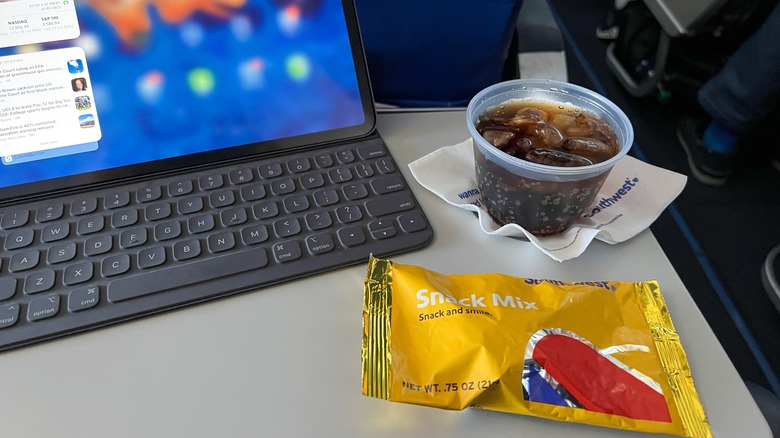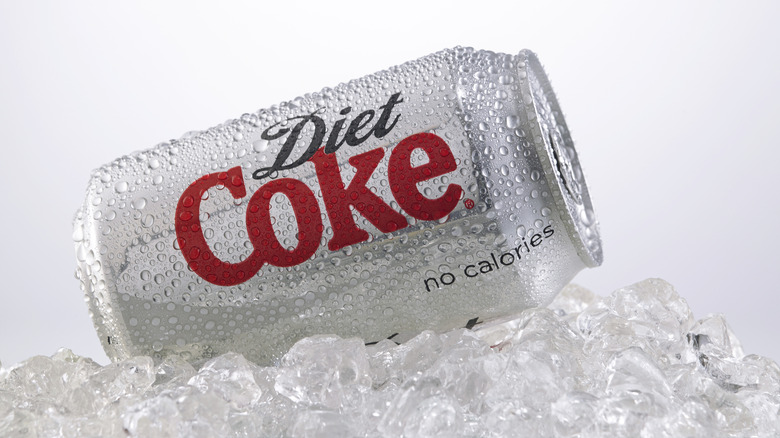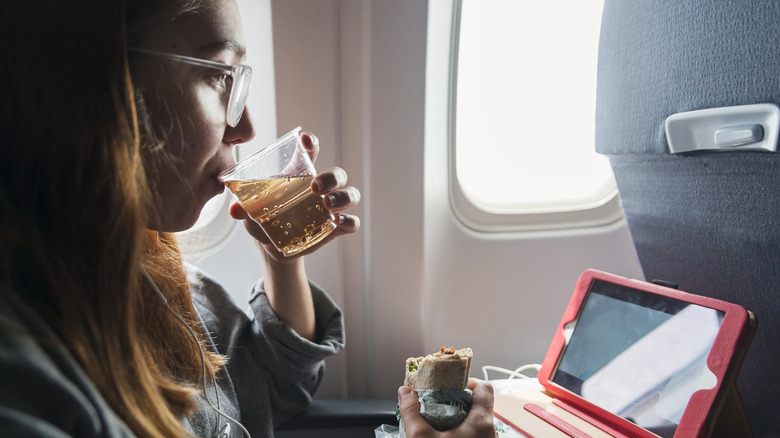Why Flight Attendants Can't Stand Diet Coke Orders
Life is different at 35,000 feet. People cry more often and more intensely when watching in-flight movies, a phenomenon attributed to mild hypoxia caused by lower oxygen levels due to cabin pressurization. The way we taste food and drinks in flight is also altered. We suddenly find it harder to discern salty and sweet flavors, while our capacity to enjoy sour and spicy flavors remains undimmed.
Another notable and unexpected change at high altitudes is how flight attendants respond to requests for Diet Coke. They hate this order. Diet Coke is very fizzy and the bubbles last for a very long time. Jet, a flight attendant and author for These Gold Wings, a blog site written for travelers by airline staff, notes that it's by far the worst drink in terms of how long it takes to serve.
Just as flying changes our taste buds, it also appears to change how sodas foam when poured from a can to a plastic cup. At least that's the case with Diet Coke. Jet claims the fizziness is so extreme he'll often start pouring a Diet Coke, then serve other drinks while waiting for its fizz to dissolve.
Why is Diet Coke so foamy in-flight?
It makes sense that flight attendants serving aisles full of passengers might dislike orders that take longer to complete, but is their disdain for Diet Coke just a personal preference, or does science back up the claim? Surprisingly, it does. According to McGill University's Office for Science and Society, the viscosity level in diet soda is higher than in regular soft drinks, making it harder for bubbles to form. Still, the bubbles that do form have more stability, meaning they're foamier and last longer.
However, that's not the only factor that affects Diet Coke's bubble duration. Surface tension also plays a part in how quickly (or agonizingly slowly) its bubbles dissipate. Diet Coke uses artificial sweeteners like aspartame that diminish the connections between molecules, leading to low surface tension in the drink, especially when served over ice cubes. The result, counterintuitively, is fizzier bubbles that last longer. Since Diet Coke is fizzier with longer-lasting foam than Coca-Cola due to its viscosity, this effect is compounded.
The drink flight attendants love to serve
We mentioned that high-altitude cabin pressurization affects our taste buds, slightly suppressing sweet and salty flavors. Well, the one drink this seems to benefit more than any other from this is ginger ale. Its sweetness may be dimmed, but this brings its drier ginger and sharper citrus flavors to the fore and makes it seem like a more sophisticated drink than the ginger ale we're used to sipping at ground level.
@akredwine For years I’ve gotten on planes and reauested Ginger-Ale knowing that I dont drink it anywhere else. I finally realized why. 💁🏾â€♀️ Source: https://www.travelandleisure.com/travel-tips/why-drink-ginger-ale-during-flight-plane #airlines #flightattendant #travellife #travelhacks #seagrams
Just as flight attendants are put off by Diet Coke's fizzy, long-lasting foam, they sing the praises of ginger ale. Flight attendant @akredwine on TikTok, for example, claims that it's one of the rare drinks whose taste improves above 10,000 feet, the point at which her airline's service begins. Not only is it a favorite of passengers, but as she displays in a popular recent video, it pours easily and smoothly, with no annoying foam.



